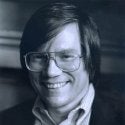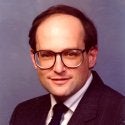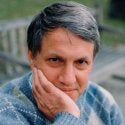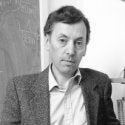In 1980, when Alan Guth first shared his ideas about inflation (a term he coined) with the scientific community, cosmology was soon transformed, but not as quickly as Guth’s own life changed. At the time he was a postdoctoral researcher at Stanford with “uncertain” job prospects, at best. “My impression is that people thought I looked smart but hadn’t done anything important,” recalls Guth. “Looking smart had gotten me good appointments so far — including graduate school at MIT and post-docs at Columbia, Cornell, and Stanford — but things didn’t look good for me getting a teaching job at a top-notch institution.”
Within a few months of his public pronouncements on inflation, Guth received calls from 10 universities offering jobs. He joined MIT’s faculty that same year, earning tenure three years later. Meanwhile, Guth became a celebrity of sorts, “receiving more than my share of attention,” as he puts it. His notebook, with the words “spectacular realization” written on it, is now on display at the Adler Planetarium in Chicago. He joined the National Academy of Sciences in 1989 and won the 2001 Benjamin Franklin Medal in Physics — an award that has been granted to such luminaries as Albert Einstein, Stephen Hawking, and Edwin Hubble.
One price of fame is that Guth now has very little time to do physics. “The number of letters of recommendation I’ve been asked to write, for example, continues to escalate,” he says. “I always fret about those letters, trying hard to say the right thing.” The late-night, early-morning hours of around midnight to 4 A.M. (which is when he had the “realization” that started all this) is about the only time people leave him alone. Even then he’s occasionally accosted by MIT students trying to make appointments to see him.
Guth gets by on little sleep — sometimes only a few hours a night — in order to keep abreast of developments in physics and pursue his own theoretical musings. “The work itself mainly consists of sitting and thinking through equations,” he explains. “First, one needs an idea of what to calculate. That comes by paying attention to your field and noting gaps that, if filled, could push things forward.”
Asked whether he feels strange contemplating the beginning of the universe when almost everyone around him is fast asleep, Guth replies, “Working at 4 A.M. doesn’t seem absurd to me. But working on theories about the first 10-to-the-minus-35th second can seem absurd at any hour. The only thing that changes that is time spent on the problem. In the long run, when some data actually agrees with these wild speculations, one begins to think we might be on the right track after all.”
For the past 22 years, Guth has devoted himself almost exclusively toward establishing a workable theory of inflation. “If this idea is right, it’s an important step in the process of discovering that everything about the universe, including its creation, is subject to the laws of physics and can be explained in terms of physics,” he says. “We’re not there yet, but if it does work out, I’d consider it a mind-boggling achievement.”
It’s more than a full-time job, especially in view of Guth’s growing obligations as a teacher, lecturer, and leader in his field. But he occasionally steals a few moments for fun. One favored pastime, which provides welcome relief from physics, is working on math problems with his son, Larry.
To hear Paul Steinhardt describe his approach to science, you might think he’s a mutual fund manager. He follows a diversified strategy, making investments in many areas of research in the hopes that some will pay off big. There is, of course, a critical difference: Steinhardt is motivated by the thrill of discovery, rather than the thrill of making money. “I like the feeling of knowing something before anyone else does, no matter what field it’s in,” explains the Princeton physicist.
Given his predilection for taking on multiple projects, a significant number of them could fail. But since there are no angry shareholders to answer to, he says, “You don’t have to tell people about all your failures, just your successes.” There have been many.
As an undergraduate, Steinhardt began working on condensed matter physics, studying the structure of glassy solids. This work eventually led him to discover a new class of matter called “quasi-crystals,” in which atoms are packed quasi-periodically (rather than periodically as in crystals), thereby making unusual symmetries possible. He continues to study the properties of these novel materials when he’s not doing cosmology.
Steinhardt’s work in cosmology began in 1980, when he was a graduate student at Harvard and heard Alan Guth’s first talk about inflation at the university. “His lecture built up to a climax and ended in disaster, as his model produced a universe that looked nothing like the one we see,” Steinhardt says. “I soon started working on ways to solve that problem, following lots of twists and turns that ended up as ‘new inflation.’ But I had a lot to learn, because I knew nothing about cosmology at the time.”
New Inflation grew out of his background in condensed matter physics, where phase transitions rule the game. “The phase transition in Alan’s model got stuck, and he didn’t know how to complete it,” Steinhardt says. “I realized that things might work better with a different type of phase transition.”
Steinhardt has developed other inflationary models since New Inflation, but these days he’s more involved in studying dark matter, dark energy, and cosmic acceleration. He coined the term “quintessence” and co-authored the first paper on the subject, after concluding that the energy driving the universe’s acceleration might vary over time rather than be a “cosmological constant,” as Einstein once posited.
“The idea of quintessence, at its simplest form, is really just inflation at a much lower energy scale.” With Princeton colleague David Spergel, Steinhardt is exploring the possibility that dark matter is strongly rather than weakly interacting — SIMPs as opposed to WIMPs — to account for the fact that matter does not clump on small scales to the extent predicted in most dark matter models. “The dark side of the universe may be far more complicated than we imagine,” Steinhardt says. “Look at how complex the five percent we know of is — dust, gas, and other matter. Why should the other 95 percent be simple?”
Meanwhile, this inflation pioneer is now one of the prime movers behind inflation’s biggest rival at present, the ekpyrotic scenario. “My hope is not to kill inflation, but to create a possible contender,” Steinhardt explains. “There’s a tendency to assume a model is correct because it’s the only one standing. The best part about having an alternative is that it opens your mind up.”
In 1981, when Andrei Linde learned of Alan Guth’s seminal paper on inflation, it threw him into a funk. “Here was this brilliant idea that did not work,” recalls Linde, who at the time was on the faculty of the Lebedev Physical Institute in Moscow. “After that, I spent quite a long time thinking about it, trying to come up with a solution.”
Some months later, he got excited about an idea that potentially solved the problem that had stumped Guth. He decided to run the notion by a friend, whom he called late at night from his bathroom so as not to wake up his wife and two kids. Encouraged by his friend’s reaction, he woke up his wife, the physicist Renata Kallosh, to modestly state: “I know how the universe began.” Thus was born New Inflation — a concept independently developed by Paul Steinhardt and Andreas Albrecht in a paper that came out shortly after Linde’s.
Although New Inflation was widely considered the first viable inflation model, the reception was not uniformly enthusiastic. Linde presented his theory at an international conference in Moscow in October 1981, and felt that “many were excited by my paper.”
Stephen Hawking spoke the next day, with Linde serving as translator. Hawking discussed an “interesting suggestion” by Linde to improve Guth’s original scenario, but said it was wrong. “For half an hour, I was translating in front of some of the top physicists in the world, explaining why my idea could not work,” Linde says. “It was extremely embarrassing for a young physicist to be crushed by such a famous scientist in this way.” Linde spoke with Hawking for several hours later that day and night, earning enough respect to be invited to a conference at Cambridge University the following summer.
In 1986, Linde fell into another funk, this one more severe than the last, largely because Soviet leader Mikhail Gorbachev had passed an edict prohibiting the nation’s scholars from publishing their work abroad. Linde felt unmotivated until he received a call from his research institute asking him to give a series of lectures in Italy. He had less than a day to provide the text of those lectures. He racked his brains, trying to figure out something new to say.
Within half an hour of frenzied thought, he came up with his theory of the “eternally self-reproducing universe.” Inflation, he concluded, was a self-perpetuating process that continually churned out new universes — radically different from our own — thanks to subtle shifts in initial conditions. “For me, this was a big breakthrough, just like Alan’s discovery of old inflation,” Linde recalls. “At that moment, many pieces of the puzzle fell into place. It was like a vision of the truth.” His depression, not surprisingly, abruptly ended.
He joined the staff of CERN, the nuclear laboratory in Geneva, Switzerland, from 1989 to 1990, with every intention of returning to the Soviet Union, where his parents lived. But he and Kallosh were soon offered faculty jobs by Stanford University. Kallosh asked a colleague whether Stanford was any good.
“It is a cultural desert,” the colleague replied, “but many people would die for such an offer.” Linde and Kallosh accepted the Stanford bid, and moved to California in 1990. While inflation is central to Linde’s work, he continues to look beyond. “Inflation is an important part of our history, but it is not the whole story,” he says. “Although it shapes the universe and forms the galaxies, it doesn’t tell us about the nature of dark matter or dark energy.”
Physics is not the whole story either, he adds. “Maybe it can take us as far as science goes, but it is not the end of all knowledge.” By combining physics, cosmology, philosophy, and theories of consciousness, Linde hopes to bring us closer to that elusive goal.
After reading a text on general relativity in high school, Alexander Vilenkin knew he wanted to become a cosmologist. But despite an obvious talent for physics, Vilenkin could not get into a graduate physics program after finishing college, nor could he find other employment in the field, primarily because he was a Jew living in the Soviet Union in the 1970s. Instead, he was forced to take a succession of mundane jobs in his hometown of Kharcov, Ukraine. For over a year, he worked as a night watchman at a kiosk that sold alcohol, and then at a zoo, studying physics whenever he could. He taught at an evening school where many students failed to show up because of drinking problems. It was his responsibility “to go to their houses and drag them there.”
Unable to pursue physics and disenchanted with the Soviet system, Vilenkin got permission to leave the country with his wife in 1976. They spent several months in Italy waiting for their U.S. visas. While in Italy, Vilenkin applied to graduate school at the State University of New York in Buffalo, where a friend of his had just been accepted. Vilenkin also was accepted, and started his graduate work in physics in September. He earned his doctorate the following spring.
His dissertation work was in the field of biopolymers, he explains, “because everyone told me I would never get a job in cosmology.” But he thought about cosmology constantly and even published a paper on black holes that year. In 1977, he accepted a post-doctoral position at Case Western Reserve in Cleveland, Ohio, in ferro-electricity, the physics of metals, but also continued his work on black holes. A year later, he joined the faculty of Tufts University in Medford, Massachusetts, ostensibly to work in condensed matter physics. He switched to cosmology right away, fulfilling a longstanding dream.
“I got lucky several times in a row,” claims Vilenkin, although skill was clearly involved as well. “It was hard to get a job in physics at the time, and Buffalo was not the world’s most famous school. It was especially unlikely that someone like me would get a job with a Ph.D. in biopolymers from Buffalo without any backing from my adviser.”
Nevertheless, Vilenkin has taken full advantage of his opportunity, remaining at Tufts ever since. In 1982, he published a paper on inflation and quantum cosmology, explaining how the universe could be created from nothing. “Quantum cosmology was not really a field at the time — and for good reason,” he says. “If you imagine a universe created spontaneously, it would be very small and nobody knew how to make it large. Inflation provides the mechanism.”
In another paper the following year, Vilenkin argued that inflation is eternal — once started, it continues without end. He’s now trying to determine whether inflation is eternal in the past, as well as into the future, which would mean the universe would not have a beginning.
Vilenkin was also a leading developer of the concept of cosmic strings — dense, linear “defects” in the fabric of space, formed during phase transitions in the early universe. The idea that these strings might act as seeds for galaxy formation was ruled out by recent microwave background observations, he says. But he does think that defects like strings exist and, if found, could teach us some interesting physics.
His work is not driven by a particular goal, Vilenkin says, “but there are some very puzzling questions that I’d very much like to understand. It’s a pleasure to think about them, and there’s always the hope that I might come up with an idea that provides some answers.”
In a recent paper, Vilenkin and a Spanish colleague, Jauma Garriga, argued that there are an infinite number of regions of space the same size as our observable universe, but that the number of “histories” — or things that could possibly happen within these realms — is finite. “The same conversation we are now having could be happening in a number of regions,” he said in an interview. “So there are regions in which I’m a tenured physics professor and others in which I’m still guarding the zoo.”













